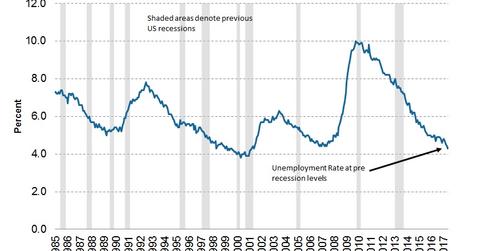Why the Fed Isn’t Satisfied with Labor Market Conditions
Despite the strong growth in employment numbers, the Fed’s latest monetary policy report had some comments about slow wage growth.
July 17 2017, Updated 9:09 a.m. ET

Lower wage growth
Despite the strong growth in employment numbers, the Fed’s latest monetary policy report had some comments about slow wage growth. The average earnings per hour have not been increasing in line with jobs.
A small increase of 0.2% was witnessed in June, after a 0.1% increase in hourly earnings in May. The average hourly earnings grew at a rate of 2.25% in fiscal 2017, and the slowdown in recent quarters has been disappointing.
Importance of labor markets
Maintaining unemployment levels below a certain level is one of the key mandates for the Fed. A healthy labor market leads to strong consumption, which helps improve demand in markets. This typically leads to increased inflation (TIP).
Yellen reiterated the strength in the jobs market, and this view was supported by the strong jobs growth in the June payroll data, which has seen a healthy addition of ~222,000 jobs—an upward revision of ~44,000 jobs for May and April.
Other employment metrics
The other metrics in labor markets remained impressive. The number of hours worked edged higher from 34.4 to 34.5, and the labor force participation rate improved from 62.7% in May to 62.8% in June. Initial jobless claims have been decreasing consistently and add to the Fed’s optimism about the labor market.
Continued improvement in the labor market benefits companies in the consumer discretionary sector (IYC) and has a long-term positive impact on the housing (ITB) and the auto industry (CARZ), as the overall consumption increases with decreasing unemployment.
In the next part of this series, we’ll analyze the Fed’s view of inflation (VTIP).
